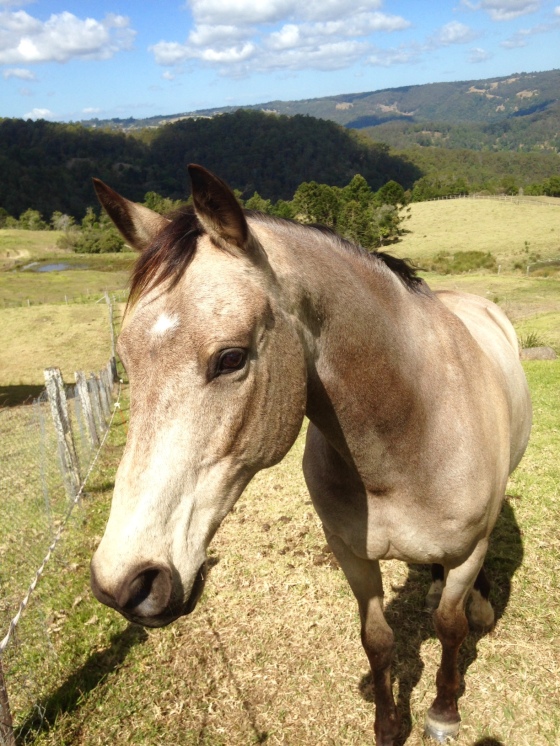
Over 8 weeks, students on a horse facilitated learning program have the opportunity to make friends with the large four legged kind. They are given timeout from school to learn how to speak horse. It is through this relationship they learn the art of ‘step back and breathe’.
From their first day, students are taught how to approach their horse in a receptive way using proximity response. As a horse turns an eye, ear or a head towards them, they take a step back and a conscious breath out. This breath out helps to relax both horse and human. It allows for a conversation to begin. They become aware of their own energy field. This is sometimes described as an energy ‘bubble’ . When we bump up against someone else’s bubble, we feel uncomfortable and take a step back instinctively to reduce uneasiness. People vary in how much personal space they need, and what’s socially acceptable or the norm varies across cultures.
Horses are a prey species that have evolved to be hyper aware using all their senses to survive. They scan our bodies for tension and continually monitor our breath, especially upon our approach. When we hold our breath, something we can do unconsciously when nervous or trying something new, the horse also feels tense. The cougar in the wild holds its breath before it attacks. Through the ‘step back and breathe’ technique, we consciously relax and repeat this several times before reaching the horse.
By approaching the horse mindfully, we ask permission to enter the horse’s space. This idea is different from what pony clubs across the land teach young riders. I was fed a mantra of ‘you have to show the horse who’s boss’ when I was a youngster learning to ride. Yes, we have to display leadership to the horse and be clear in our actions which makes the horse feel safe. However, true leadership is a hell of a lot more than dominance and control. Winston Churchill, an inspiring leader for his time said
‘Courage is what it takes to stand up and speak; Courage is also what it takes to sit down and listen’.
It is the latter part of this quote that is the other half of the story. In using proximity response, we are listening for the horse’s answer.
 Over the course of the program, students become aware of what’s going on inside their bodies. They learn to find out what’s ‘running’: be it fear, anger, frustration or any other emotion. Horses are super sensitive to picking up our emotions. By simply placing our hand on the body part where the unease is felt, we can dissipate the energy. We teach people how to do a body scan before approaching the horse and bring their energy within. Horses are sleuths when it comes to incongruency, a psychology term coined in 1950s. It happens when people are distracted, emotional and disconnected from their body. When someone is totally unaware of what’s going on inside them even if they are putting on a brave face or talking the talk. The emotion felt from them doesn’t match their behaviour. Horses don’t want to hang with us in this state as we’re unclear and potentially dangerous. However, horses willingly hold space for feelings, but they will only support once we honestly acknowledge our feelings, and become relaxed which happens naturally once we allow ourselves to feel.
Over the course of the program, students become aware of what’s going on inside their bodies. They learn to find out what’s ‘running’: be it fear, anger, frustration or any other emotion. Horses are super sensitive to picking up our emotions. By simply placing our hand on the body part where the unease is felt, we can dissipate the energy. We teach people how to do a body scan before approaching the horse and bring their energy within. Horses are sleuths when it comes to incongruency, a psychology term coined in 1950s. It happens when people are distracted, emotional and disconnected from their body. When someone is totally unaware of what’s going on inside them even if they are putting on a brave face or talking the talk. The emotion felt from them doesn’t match their behaviour. Horses don’t want to hang with us in this state as we’re unclear and potentially dangerous. However, horses willingly hold space for feelings, but they will only support once we honestly acknowledge our feelings, and become relaxed which happens naturally once we allow ourselves to feel.
It is quite possible that if we all learnt to ‘step back and breathe’ during times of heightened emotions, the world would be a calmer place. When we react in the moment, saying things in anger or throwing that punch, we are trapped in the reptilian part of our brain (our primal brain). By taking a few precious moments to step back and breathe, we can engage the prefrontal cortex, the thinking part of our brain, allowing for more conscious, peace evoking responses. Through this humble action, we could change the world, one step at a time.


Nice stuff Ames! Definitely food for thought.
LikeLiked by 1 person
Ames you are incredible with a very big passion and the kindest of hearts
LikeLiked by 1 person
Beautiful and wise…..💋
>
LikeLiked by 1 person